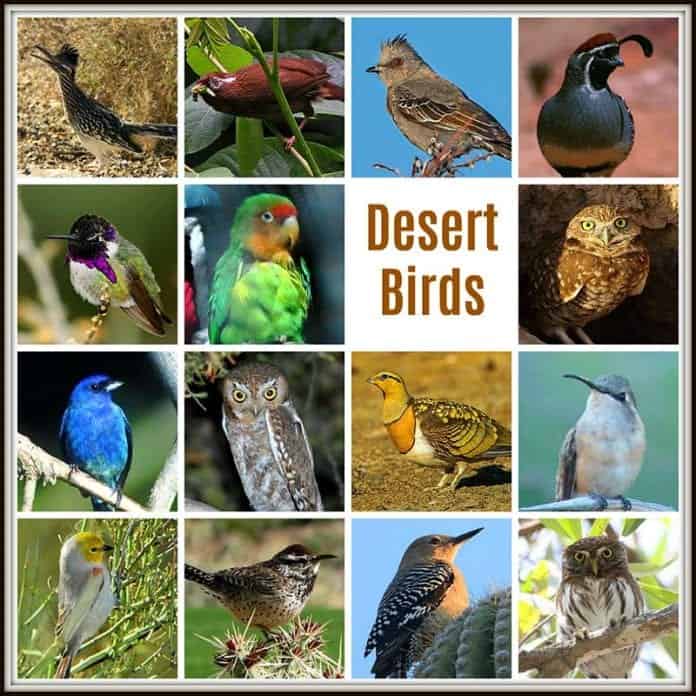
Desert Birds: A desert is a barren landscape area with little to no water (no precipitation) is found which makes the living condition extremely hostile for plants and animals.
In this extreme condition, there are different desert birds which thrive with many developed adaptations. Let’s explore 15 such desert birds and their unique adaptations on this page.
Table of Contents
- Desert Birds & Adaptations
- 1. Cactus Wren (Campylorhynchus brunneicapillus)
- 2. Lucifer Hummingbird (Calothorax lucifer)
- 3. Greater Roadrunner (Geococcyx californianus)
- 4. Verdin (Auriparus flaviceps)
- 5. Indigo Bunting (Passerina cyanea)
- 6. Gila Woodpecker (Melanerpes uropygialis)
- 7. Hwamei (Garrulax canorus)
- 8. Ferruginous Pygmy Owl (Glaucidium brasilianum)
- 9. Rosy-faced Lovebird (Agapornis roseicollis)
- 10. Pin-tailed Sandgrouse (Pterocles alchata)
- 11. Burrowing Owl (Athene cunicularia)
- 12. Phainopepla (Phainopepla nitens)
- 13. Elf Owl (Micrathene whitneyi)
- 14. Costa’s Hummingbird (Calypte costae)
- 15. Gambel’s Quail (Callipepla gambelii)
Desert Birds & Adaptations
1. Cactus Wren (Campylorhynchus brunneicapillus)
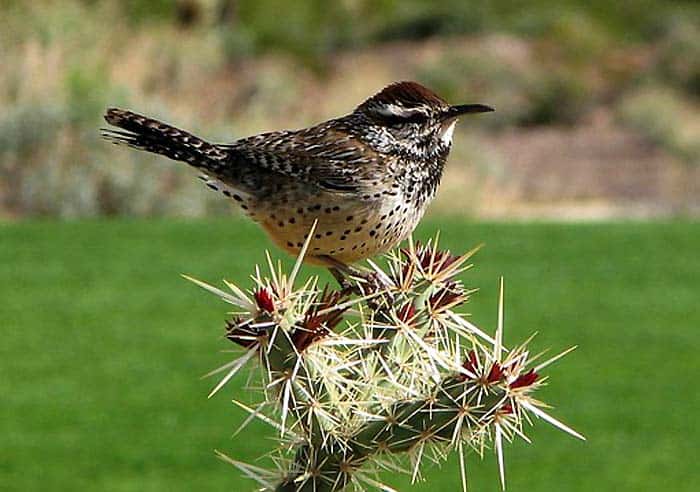
The Cactus Wren is considered to be the largest type of wren in the US. In terms of size, it is closely similar to that of the Spotted Towhee.
The wren is characterized by having short rounded wings but a long rounded tail and long heavy bill. In terms of color, it is color brown with white “eyebrows“.
Diet: The bird normally feeds on insects such as beetles, wasps, grasshoppers, and ants. Sometimes, it also eats fruits and small frogs, and small reptiles.
Geographical Distribution: In general, these desert birds are distributed throughout the South Western deserts.
Adaptations: Unlike most wrens, Cactus wrens can be normally found perched on top of shrubs and cacti (hence their name). They do this to announce their presence.
![]()
2. Lucifer Hummingbird (Calothorax lucifer)
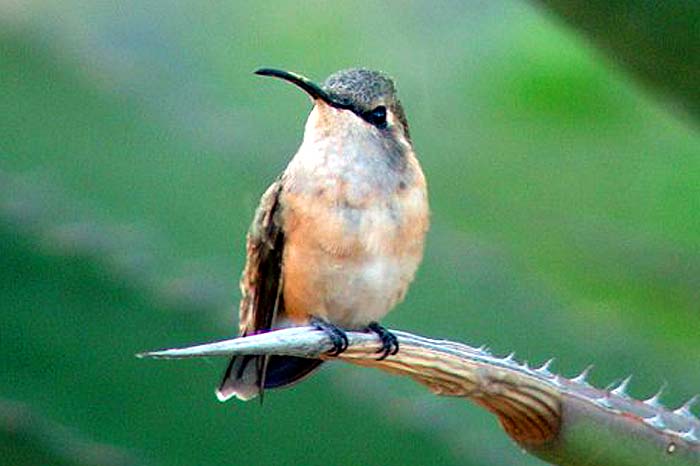
Birds of this species are sexually dimorphic. Males are characterized by having dominant iridescent plumage and a purple-colored gorget that flares out on the sides. On the other hand, females are characterized by having iridescent green plumage with a cinnamon patch on the upper feathers.
Diet: Lucifer hummingbirds normally feed on nectar from plants like agave, anisacanth, and penstemon. Sometimes, they also feed on insects.
Geographical Distribution: This bird is mostly found in the northern and central parts of Mexico. Sometimes, it can also be found in west Texas and some parts of southern Arizona.
Adaptations: Birds of this species are highly adapted to deserts, most of the time feeding on forage found in the biome. Aside from that, they have developed a unique call in the form of a shrill shriek.
![]()
3. Greater Roadrunner (Geococcyx californianus)
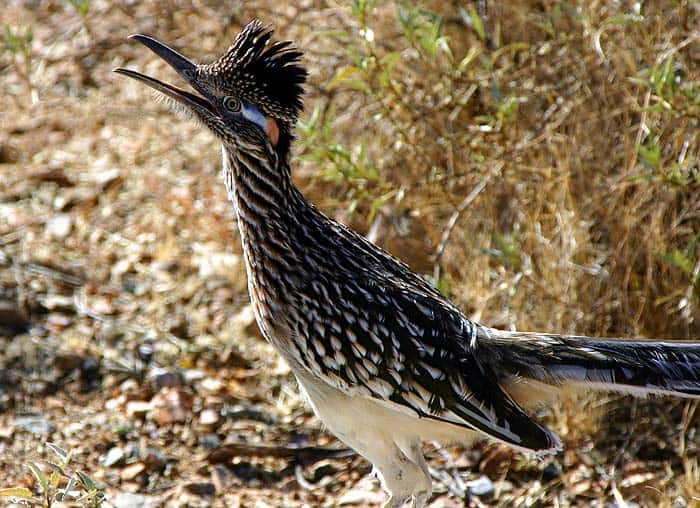
In terms of appearance, the Greater Roadrunner is characterized by a very distinct shape-a straight tail and a very long neck and a slightly-curved bill. Its head has a short crest.
Diet: Birds of this species eat insects, small reptiles and birds, mice, and fruits, all of which they find on the ground.
Geographical Distribution: The Greater Roadrunner inhabits the dry open country, mostly in North America. However, they are not restricted to deserts only, as they also inhabit places with patches of small trees and shrubs.
Adaptations: Unlike other types of birds that resemble their appearance, the Greater Roadrunner runs rapidly across the ground to look for prey. It does this by cocking its tail upward.
![]()
4. Verdin (Auriparus flaviceps)
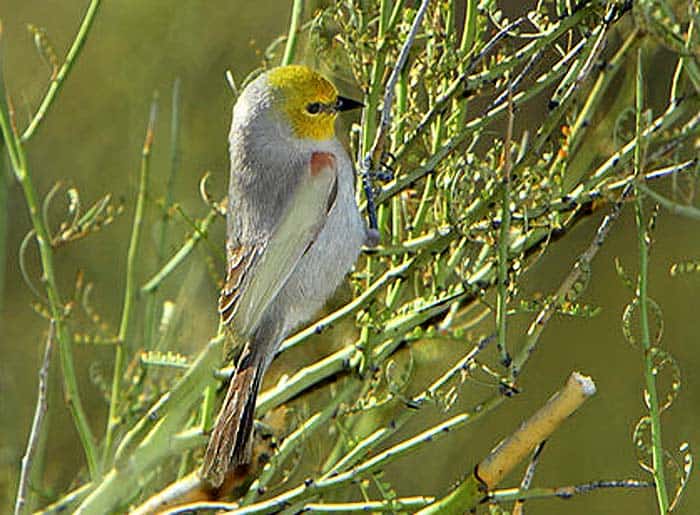
When young, Verdins are characterized by having an overall gray plumage, and short bills that are thick at the base and pointed at the tip. As they grow old, they grow yellow feathers on their heads and patches of chestnut-colored feathers on their shoulders.
Diet: Verdins feed dominantly on insects like caterpillars, insects, beetles, larvae, and small spiders. Sometimes, they also eat small fruits like berries and small seeds.
Geographical Distribution: Verdins are usually found in the thorny shrub vegetation of the southwestern United States and northern Mexico.
Adaptations: To adapt to the scorching heat of the desert summer, Verdin birds stay in the shaded inner parts of shrubs. Aside from that, they build nests that are open in the direction of the wind as an additional cooling mechanism.
Suggested Reading:
Top 18 BEST Tundra Animal Adaptations
![]()
5. Indigo Bunting (Passerina cyanea)
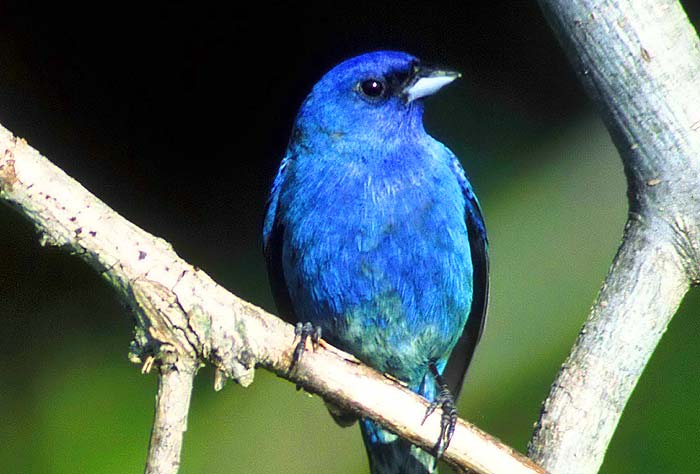
Generally, all Indigo Buntings have short beaks and dark-colored legs. Male birds of this species have brilliant blue plumage and darker blue (almost purple) plumage during the breeding season. On the other hand, the females and juvenile birds are brown-colored and have only a tinge of blue on their tails.
Diet: Interestingly, Indigo Buntings do not usually drink water; instead, they get their water requirement from their diet. Generally, they feed on small insects (e.g., bugs, beetles, caterpillars, small spiders), berries, herbs, and seeds of grasses.
Geographical Distribution: This bird is mostly found in the eastern parts of North America from the southern parts of the coniferous forest region. Aside from that, they could be occasionally found in some parts of the western US like California, Utah, and Arizona.
Adaptations: Indigo Buntings are considered to be migratory birds that can fly as far as 3500 kilometers. They migrate in flocks at night and leave during winter and breeding seasons.
![]()
6. Gila Woodpecker (Melanerpes uropygialis)
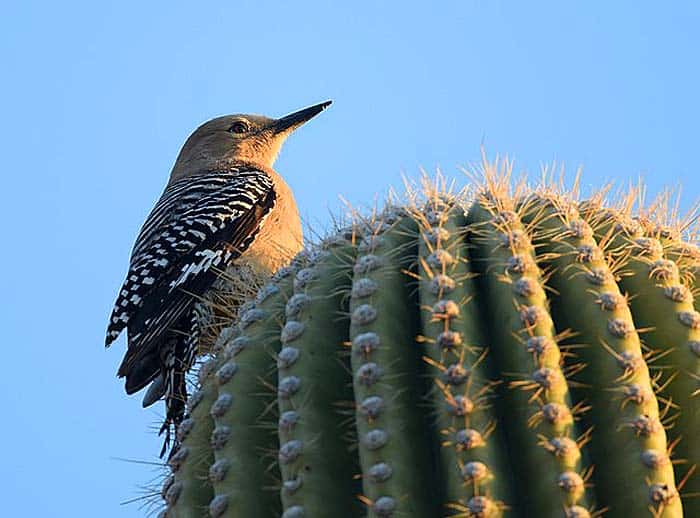
Males are colored barred black and white, have tan heads and bellies, and have a red crown patch. Females also have the same plumage color but lack the crown patch.
Diet: The diet of Gila Woodpeckers mainly composes of insects but occasionally consists of cactus fruits and small berries (i.e., mistletoe berries). Interestingly, these desert birds have learned to lick up the sugary water like backyard hummingbirds.
Geographical Distribution: Gila Woodpeckers are distributed in the regions of southeast California, southern Arizona, southwest Nevada, and some parts of Mexico.
Adaptations: This species of woodpecker is characterized by having very flexible head and neck muscles, a long, pointed beak, and a long tongue that can withstand the pressure of pecking into hard materials like trees.
![]()
7. Hwamei (Garrulax canorus)
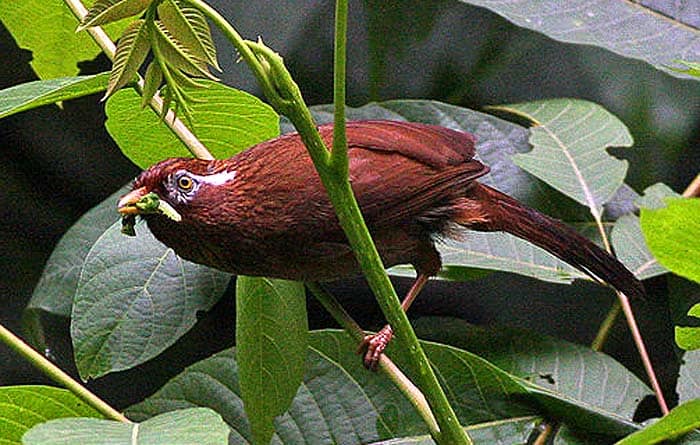
Hwamei birds are medium-sized birds characterized by having overall olive-brown plumage, gray bellies, and faint black bars on the tails. Aside from that, they have distinct blue-white eye rings and lines behind their eyes.
Diet: The diet of Hwawei birds is mostly insect-based which includes locusts and their eggs, ants, beetles, caterpillars, and other small insects. During breeding seasons, they also feed on corn and small seeds of crops.
Geographical Distribution: This bird species is endemic to the western and southern parts of China and some parts of Laos. Once abundant in Vietnam, their number declined rapidly due to trapping pressure.
Adaptations: The Hwamei is also sometimes called the “Melodious Laughing Thrush” because of its very distinct, long, melodious song. Despite this, the Hwamei is very difficult to find in the wild.
![]()
8. Ferruginous Pygmy Owl (Glaucidium brasilianum)
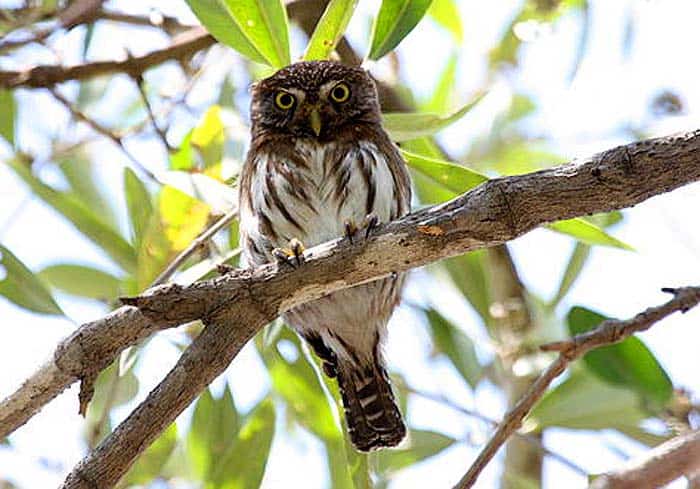
This bird species is considered to the most numerous in the genus Glaucidium. Basically, Ferruginous Pygmy Owls are characterized by having distinct black marks on their napes, long tails, and large rounded heads. Overall, they have dull grayish-brown plumage with white underparts.
The Ferruginous Pygmy-Owl is now considered to be endangered in Arizona and is currently experiencing rapid loss of habitat in Arizona and Texas.
Diet: Most active near dawn and dusk, this bird species mainly feed on insects (e.g., beetles, crickets, and caterpillars), scorpions and spiders, small birds, lizards, and small rodents.
Geographical Distribution: This bird occurs in a wide variety of habitats, such as the lowlands of the Neotropics up to the southern parts of the US and Argentina.
Adaptations: Ferruginous Pygmy-Owls do not migrate despite changing seasons. During early spring or late winter, they normally start to nest in tree cavities or cacti holes often made by woodpeckers.
![]()
9. Rosy-faced Lovebird (Agapornis roseicollis)
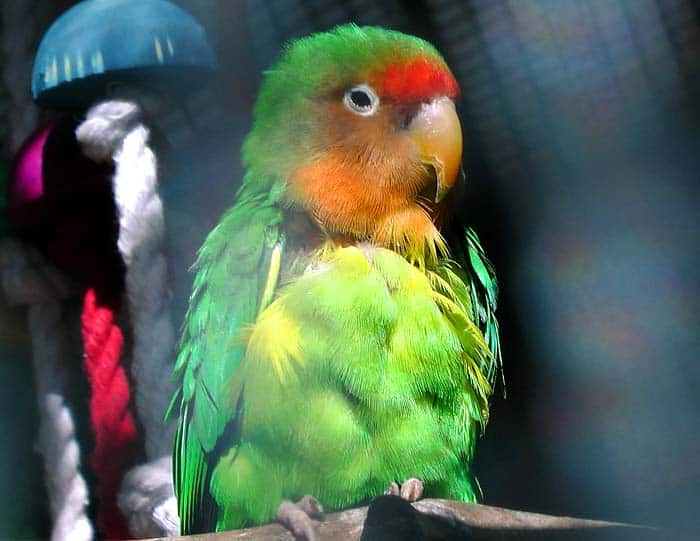
Formerly called as Peached-faced Lovebird, this bird is easily identifiable because of its rose to peach-colored face (hence the name). Overall, they have a green plumage with tinges of blue on their backs.
Diet: Like any other lovebird, the Rosy-faced Lovebird normally feeds on small fruits and small seeds of plants, seed pods, and cactus fruits.
Geographical Distribution: This bird is endemic to the arid wooden country in southwestern Africa, such as Angola, Namibia, Northern Cape Province, and others.
Adaptations: The Rosy-faced Lovebird is highly adapted to life in the desert. But despite being common in dry regions, this bird is highly dependent on areas near water sources. It may exhibit nomadic tendencies when the water supply is little or unavailable.
![]()
10. Pin-tailed Sandgrouse (Pterocles alchata)
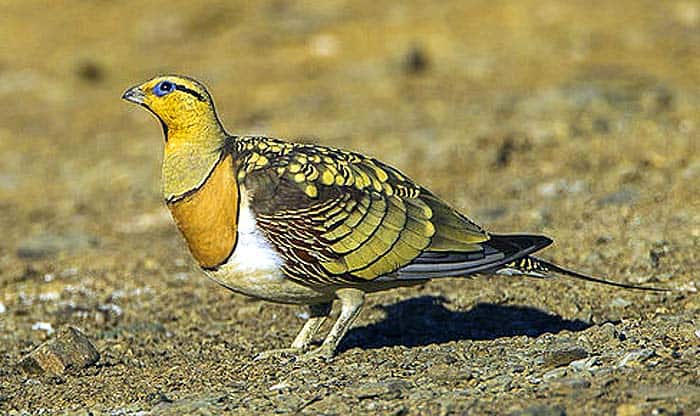
Male Pin-tailed Sandgrouses have a colorful plumage consisting of a yellowish face, neck, and upper chest, and golden spots on the shoulders and back. On the other hand, females are less colorful, having a whitish chin and grayish wings with black patches.
Diet: The diet of this bird species mainly consists of small seeds such as legumes and grains. Aside from that, they also feed on small plant parts like leaves, green shoots, and flowers.
Geographical Distribution: These desert birds are mostly found in the arid to semi-arid regions of northwestern Africa, North Africa, the Middle East, southeastern Turkey, and some parts of Europe.
Adaptations: The Pin-tailed Sandgrouse is highly adapted to life in very arid areas because of their dense plumage. Interestingly, those feathers give them enough insolation against the warm weather.
![]()
11. Burrowing Owl (Athene cunicularia)
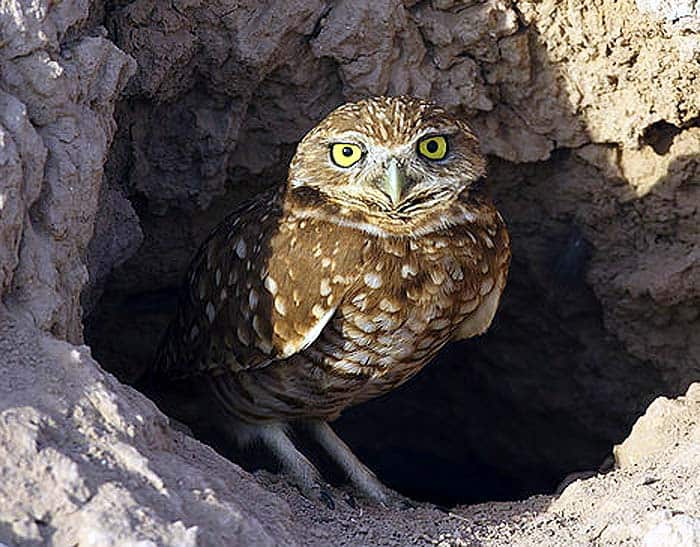
Considered to be one of the smallest owls in North America, Burrowing owls are characterized by having brown-spotted plumage, and distinct eyebrows located above their bright yellow eyes.
Diet: Birds of this species normally feed on small insects like beetles, caterpillars, moths, as well as small animals like birds, lizards, snakes, and rodents.
Geographical Distribution: Burrowing owls normally inhabit the grassland, farmlands, prairies, and other flat areas with small grass cover. Burrowing owls can be found in South America, some parts of Florida, and the Caribbean Islands.
Adaptations: As their name suggests, Burrowing Owls live in the underground burrows that were created by digging animals like prairie dogs and ground squirrels. Mostly nocturnal, the Burrowing Owl hunts at dusk and night. However, it may also hunt the prey for additional food reserves during mating and breeding seasons.
![]()
12. Phainopepla (Phainopepla nitens)
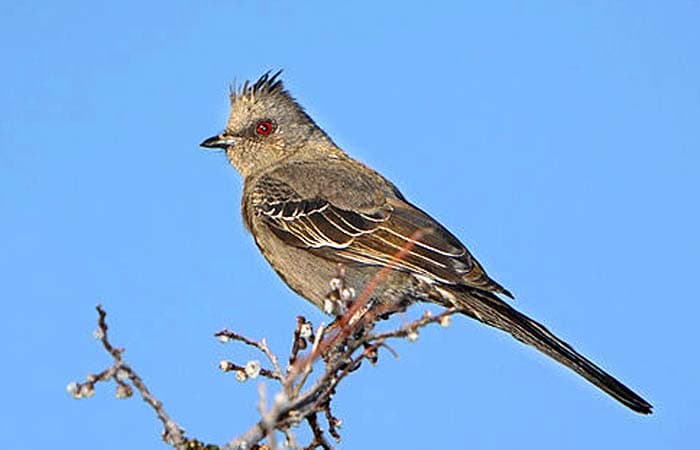
Sexual dimorphism is demonstrated in this bird species. Males generally appear to be glossy black and zigzag. When they fly, they flash white wing patches (which thus inspired the Greek name “Phainopepla” meaning “shining robe“. On the other hand, females appear to be dull in appearance, having a gray overall plumage color.
Diet: Phainopeplas feed heavily on the berries of the parasitic plant, mistletoe. However, they also occasionally catch flying insects.
Geographical Distribution: These birds typically live in the deserts and dry woodlands of the southwestern regions of Mexico and the US.
Adaptations: Birds of this species exhibit varying behaviors depending on the type of habitat they are in. These birds become territorial in the desert and actively defend their nesting and foraging areas. However, in the woodlands, they tend to be colonial and nest with four other pairs to share a single tree.
![]()
13. Elf Owl (Micrathene whitneyi)
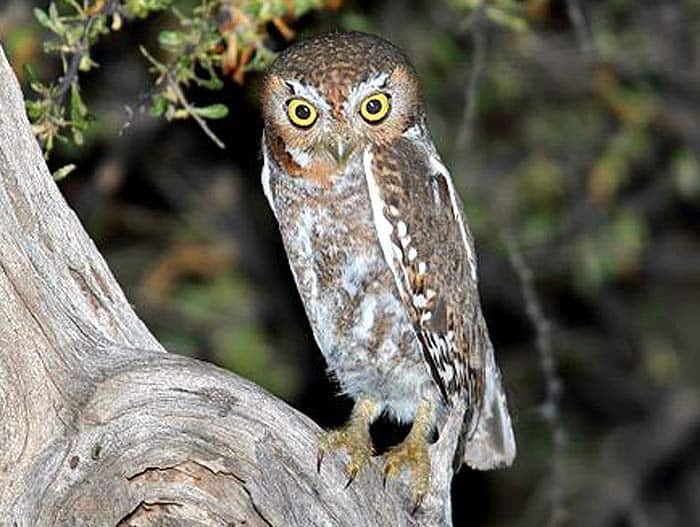
Considered the smallest owl in the Sonoran Desert, the Elf Owl lacks the usual “ear tufts” among most owls. Generally, they have grayish-brown plumage, pale yellow eyes with white eyebrows, and gray bills.
Diet: Like most owls and other birds, Elf Owls primarily feed on insects like beetles and crickets, as well as other invertebrates like scorpions, and centipedes.
Geographical Distribution: In general, Elf Owls can either be found in places where there is a water supply or in regions where the Sagauro cactus are abundant. Overall, these owls inhabit the southwestern parts of the US, Central Mexico, and the Pacific slope north to Mexico.
Adaptations: Like any other owls, Elf Owls have superb vision even in low-lighted areas. In particular, Elf Owls utilize a so-called “silent flight” wherein they don’t make any noise to catch their prey. This is easily done because of the softened feathers on their wing edges.
![]()
14. Costa’s Hummingbird (Calypte costae)
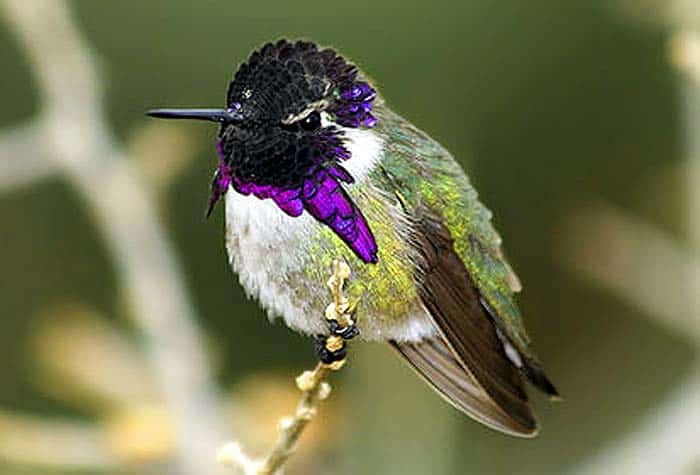
Like most hummingbirds, Costa’s hummingbird is small in size (approximately 9 cm in length). In terms of appearance, males are more colorful with black faces, violet crowns and throat patches, and green underparts. On the other hand, females have green crowns, white throats, and greenish-grey underparts.
Diet: Costa’s Hummingbirds feed mainly on nectar from flowers like honeysuckle, agave, fairy duster, and Chuparosa. Occasionally, these birds also feed on insects.
Geographical Distribution: Costa’s Hummingbirds are endemic to the Southwest. However, some evidence suggests that they have shown up in regions like Alaska, Canada, British Columbia, and Pacific Northwest.
Adaptations: These birds are highly adapted to warm climates. However, when subjected to lower temperatures, Costa’s hummingbirds can go into a torpid state. In this condition, their heart rates are greatly reduced, and their body temperatures also decrease.
![]()
15. Gambel’s Quail (Callipepla gambelii)
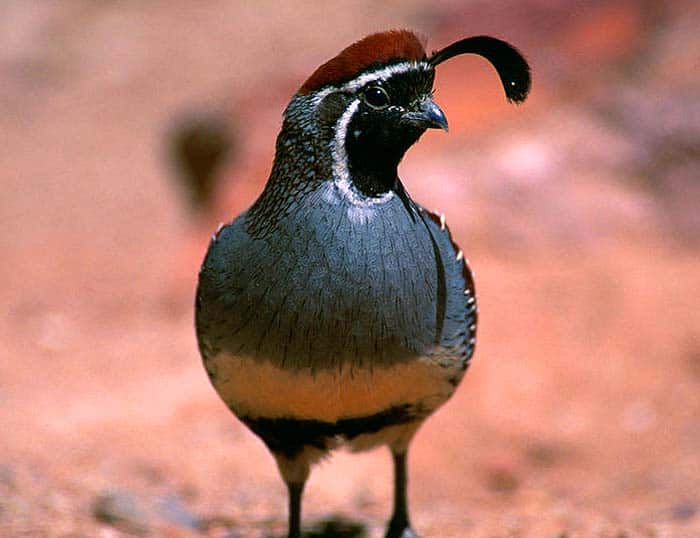
Like any other types of quail, the Gambel’s Quail is characterized by having a round body and a head crest (known as a plume). Males are easily distinguishable because of their thick and dark plume, black face and neck, and black patch on the chest. On the other hand, females have duller plume color and lack black patches.
Diet: A dominant portion of the Gambel’s Quail’s diet consists of plants. Most of these include different types of seeds, leaves, berries, and even cacti. During nesting seasons, the bird also feeds on different kinds of insects.
Geographical Distribution: These desert birds live well in warm regions with thorny vegetation. They are found exclusively in Arizona, but their range can extend up to the regions of Mexico, Texas, California, and Colorado.
Adaptations: To avoid their predators (i.e., snakes, coyotes, foxes, etc.), these birds will stay motionless and use camouflage by hiding in the vegetation. These birds also exhibit an interesting way of incubation. When the female Gambel’s Quail is not available or is dead, the male will try to do the process of incubating instead.
![]()
While most of the desert birds in this tabulated list are of the least concern regarding their conservation status, it is essential to note that human activities can, directly and indirectly, endanger these species. For this reason, the most appropriate things to prevent the decreasing population of these organisms are (1) to protect them and their numbers and (2) to protect their habitats. By doing so, we do conserve not only the earth’s biological diversity but also the health of the environment as well.
![]()



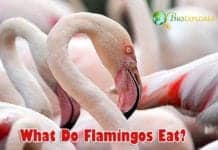
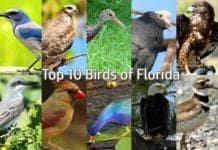


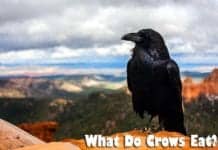
















[…] contrast, desert birds use evaporative cooling, where they use water to transfer heat-away from their bodies just like how […]
[…] contrast, desert birds use evaporative cooling, where they use water to transfer heat-away from their bodies just like how […]